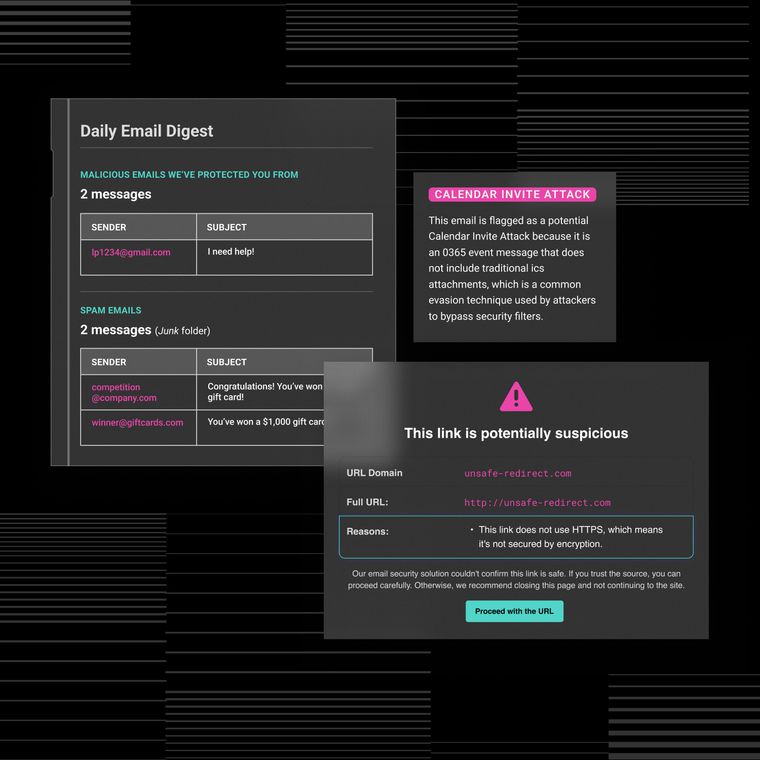Effective Cybersecurity Solutions Every Business Needs to Have in Place
Discover the foundational cybersecurity solutions every business should deploy to stay secure and compliant.
July 28, 2025
“The rapid evolution of threats means that legacy cybersecurity solutions are no longer sufficient to protect today’s enterprises.” — Evan Reiser, CEO, Abnormal Security.
Every business needs three core cybersecurity technologies: endpoint protection, network security, and email security. With the average breach costs hitting $4.9 million, the stakes demand precision over proliferation. Abnormal found that more than 70% of organizations plan to increase their investment in AI-driven cybersecurity solutions over the next year. There has been concern about increasing malware infections and targeting of personal information through phishing links, email addresses, and vulnerable endpoints in the first half of 2024.
Knowing what to do after a phishing attack matters, but prevention through layered defense architecture matters more. The cybersecurity market floods organizations with overlapping platforms and buzzword-heavy solutions that create confusion instead of clarity. The three technologies covered here form your security foundation—each layer complements the others and closes gaps attackers exploit. Deploy these correctly, and you reduce risk, satisfy compliance requirements, and maintain visibility without budget bloat or tool sprawl.
1. Endpoint Protection
Endpoint protection are measures that protect different devices or endpoints that are connected to a network from cyber threats. This type of protection keeps every laptop, server, and mobile device you manage from becoming cyberthreats, making it the first control you should lock down.
You will see two acronyms everywhere: an EPP and EDR pair. The Endpoint Protection Platform (EPP) blocks known threats with next-generation antivirus, device encryption, and application control. Endpoint Detection and Response (EDR) watches what slips past prevention, flagging abnormal behavior and quarantining compromised hosts in real time. The most effective tools merge both engines, so you prevent commodity malware and still catch fileless exploits, living-off-the-land attacks, and insider abuse without juggling multiple agents.
Real-Life Workflow Example: A marketing employee receives a PDF invoice that appears legitimate. The EPP scans the file upon download and allows it since no known malware signatures are detected. When opened, the PDF executes a PowerShell script that attempts to contact a command-and-control server.
The EDR component immediately flags this unusual behavior, blocks the network connection, quarantines the endpoint, and alerts the security team. The security team then investigates the incident, determines it was a zero-day attack, and pushes new detection rules to all other endpoints in the organization, which prevents a potential company-wide breach.
Why It Matters
Compromised devices remain the fastest route to a breach, and business leaders know it: only 34% of security leaders believe their current cybersecurity solutions provide adequate protection against evolving threats. Downtime that follows a ransomware detonation or destructive wiper attack erodes revenue, erases customer trust, and can push the average incident cost well above the $4.9 million breach benchmark. Robust endpoint telemetry also simplifies regulatory audits by logging every action, giving CISOs clear board-level metrics, shrinking IT workload through automation, and handing compliance officers the evidentiary trails they need for HIPAA or PCI-DSS sign-off.
Key Features to Look For
Next-generation antivirus driven by machine learning should sit at the core, but you also need behavioral analytics that score every process by intent rather than signatures alone.
Ransomware guards are non-negotiable; look for rapid file-change detection and automated rollback.
Application allow-listing blocks unapproved executables, while exploit protection hardens browsers, office suites, and legacy apps that rarely see patches.
Centralized dashboards give you visibility across thousands of endpoints and let you push updates or isolation commands in one click.
Expert Tips
Follow these proven practices to maximize your endpoint protection investment:
Start with a risk assessment to pinpoint devices that handle sensitive data or access privileged networks, then protect them first.
Turn on automatic patching for operating systems and common applications to close exploitable gaps before attackers scan for them.
Require multi-factor authentication at logon and for any privilege escalation, reducing the impact of stolen credentials.
Stream endpoint alerts into your SIEM so you correlate user, network, and cloud activity in one timeline and spot multi-stage attacks early.
2. Network Security Solutions
Your network security stack should implement robust blocking, inspection, and verification of network traffic to help prevent attackers from reaching sensitive data or moving between systems. This second layer of defense works hand-in-hand with endpoint protection to create multiple barriers that criminals must overcome.
Network security creates layered shields that follow data wherever it travels. The outer layer sits at the perimeter. This includes cloud gateways, edge firewalls, and secure VPN concentrators that decide which connections reach your environment. Inside, segmentation breaks the corporate LAN into tightly scoped zones, forcing every request through policy checks. Continuous monitoring watches east-west traffic for subtle signs of compromise. When each layer knows what "normal" looks like, you gain both prevention and rapid detection.
Real-Life Workflow Example: A finance employee working remotely connects to the corporate network through a VPN. The perimeter firewall authenticates their connection using multi-factor authentication and validates their device's security posture before allowing access. Once connected, when they attempt to access the financial database, zero-trust controls verify their identity again and check if their access request matches their normal behavior pattern.
Later, when the employee tries accessing engineering servers—something outside their typical activity—the network security system immediately flags the anomalous lateral movement, restricts access, and alerts the security team to investigate this potential account compromise.
Why It Matters
Attackers rarely smash through the front door anymore; they sneak in through a vendor's compromised software update, then pivot across flat networks. Supply chain incidents alone disrupted 183,000 downstream customers last year, a 33 percent jump over 2023. Once inside, ransomware crews move laterally, encrypt backups, and exfiltrate data for double extortion.
Layered network controls translate directly into reduced residual risk and calmer board updates. Your IT team gains visibility and automation, reducing the time spent managing ACLs on legacy hardware. Compliance officers see hard evidence of PCI-DSS and SOX controls—encryption in transit, access logs, and segmentation—all ready for auditors.
Key Components
Firewalls filter packets, perform stateful inspection, and participate in network segmentation strategies. Modern next-generation models understand application context, letting you allow payroll traffic while rejecting an identical protocol from an unknown host.
Intrusion detection and intrusion prevention systems (IDS/IPS) analyze flow records and payloads. An IDS quietly alerts you to anomalies; an IPS blocks malicious sequences in real time.
Zero-trust architecture ties these controls together. Instead of assuming everything inside is friendly, zero trust demands continuous verification and least-privilege access for every user, device, and workload. Identities are authenticated at each hop, and policies evaluate context—location, device health, and time of day before granting minimal permissions.
Strong encryption keeps this foundation solid. Transport Layer Security (TLS) is table stakes for web traffic, but you should extend end-to-end encryption to APIs, remote management ports, and file transfers. When ciphertext is useless to eavesdroppers, man-in-the-middle attacks lose their punch.
Expert Tips
These best practices ensure your network stops feeling like an open highway and starts acting like a series of secure, well-lit checkpoints:
Map your critical assets, then write least-privilege firewall rules that expose only required ports and protocols
Require remote employees to connect over VPN or ZTNA with multi-factor authentication
Segment production, development, and administrative networks so a single phished credential cannot traverse them
Schedule quarterly penetration tests and vulnerability scans; feed findings into IPS signatures and zero-trust policies
3. Email Security
Email security prevents the highest-impact threats, phishing and business email compromise, from reaching employee inboxes. This third pillar complements your endpoint and network defenses by stopping attacks at their most common entry point.
Every email address becomes a target when you rely on email for contracts, invoices, and personal information. Modern platforms deploy spam and phishing filters, attachment sandboxing, authentication checks, and continuous behavioral analysis. Legacy filters searched for known bad domains, but criminals now create one-time URLs and craft AI-generated copy that appears legitimate.
Today's platforms inspect each header, link, and attachment in real time, correlating that data with ongoing user behavior to stop attacks that bypass static rules. This approach addresses a critical gap: More than 90 percent of successful breaches still start with an email, according to authoritative cybersecurity industry reports.
Real-Life Workflow Example: The CFO receives an email appearing to come from the CEO requesting an urgent wire transfer. The email security platform first authenticates the sender against DMARC records and detects that the domain is slightly misspelled (ceo@companynamee.com vs. ceo@companyname.com).
The system also recognizes the unusual request pattern and identifies that the sending IP originates from a high-risk region. The message is automatically quarantined, with notifications sent to both the security team and the CFO. When the CFO reports the incident, the security team uses this intelligence to create new detection rules, conduct targeted training, and implement stricter wire transfer verification protocols, preventing what could have been a six-figure loss.
Why It Matters
BEC remains one of the costliest cybercrimes, with median losses far outpacing ransomware. For CISOs, comprehensive reporting proves diligence to the board and auditors. For IT managers, machine-learning filters reduce false positives that would otherwise overwhelm help-desk queues. Compliance officers gain immutable logs that tie every blocked message to a policy control, simplifying audits for frameworks such as PCI-DSS and HIPAA.
Key Features to Look For
Strong authentication forms the foundation. Enforce MFA for every mailbox so stolen passwords alone cannot grant access.
End-to-end encryption keeps sensitive data unreadable in transit.
AI-driven anti-phishing engines evaluate sender reputation, detect look-alike domains, and detonate suspicious attachments in isolated sandboxes.
Protocol enforcement, such as SPF, DKIM, and strict DMARC policies, prevents domain spoofing.
Behavioral analytics learn each user's normal patterns; sudden vendor payment requests or midnight logins from new devices trigger immediate alerts.
Integration with your SIEM or SOAR ensures alerts flow into the wider incident-response process.
Expert Tips
These controls transform email from the easiest entry point to the hardest, closing a channel that attackers have exploited for decades:
Publish a 'reject' DMARC policy to significantly reduce attackers' ability to spoof your domain
Require MFA everywhere, especially after a phishing attack, to contain any compromised credentials
Run monthly simulated phishing drills, then coach employees who click a suspicious email or open a rogue attachment
Feed email threat telemetry into endpoint and network tools; unified visibility accelerates containment when an employee clicks a malicious message
Review executive and finance mailboxes weekly; they are prime BEC targets and often hold the most sensitive personal information
Building Your Integrated Security Foundation
Endpoint, network, and email security form the backbone of any credible defense strategy. When these layers work in concert; they share telemetry, enforcing least-privilege access, and applying AI-driven detection. It allows you to gain a continuous feedback loop that closes gaps before attackers exploit them.
For email security, Abnormal Security offers a comprehensive solution that perfectly complements this integrated approach. Leveraging advanced behavioral AI, Abnormal Security analyzes communication patterns, user behaviors, and content context to identify even the most sophisticated BEC attempts and social engineering attacks that traditional tools miss. Request a customized demo to learn how behavioral AI can help protect your business.
Related Posts
Get the Latest Email Security Insights
Subscribe to our newsletter to receive updates on the latest attacks and new trends in the email threat landscape.


